If you need a single device that prints, scans, copies and sometimes faxes, you’re in the right place. An all‑in‑one model combines tasks so you save space and avoid juggling separate machines. That convenience matters whether you work from a small office corner or manage family projects.
You’ll learn how connectivity and cloud apps let you print from phones, tablets, or a laptop without being tied to a desk. We’ll cover speed, print quality, page costs, duplex setups, and feeder capacity so you can match a device to your daily workload.
Expect clear guidance on ink versus toner choices, common subscription plans, and brand strengths from HP, Brother, and Canon. That helps you avoid small trays, weak duty cycles, or hidden supply costs that don’t fit your routine.
Key Takeaways
- One compact unit can replace multiple machines and save space.
- Look for speed, page cost, and duplex when comparing models.
- Mobile and cloud printing make day-to-day tasks faster and easier.
- Ink vs. toner affects running costs and output for color and black text.
- Check duty cycle and feeder size for your expected volume.
How to choose a Wireless All-in-One for your home office right now
Know your printing habits first—page counts and features decide which model works best.
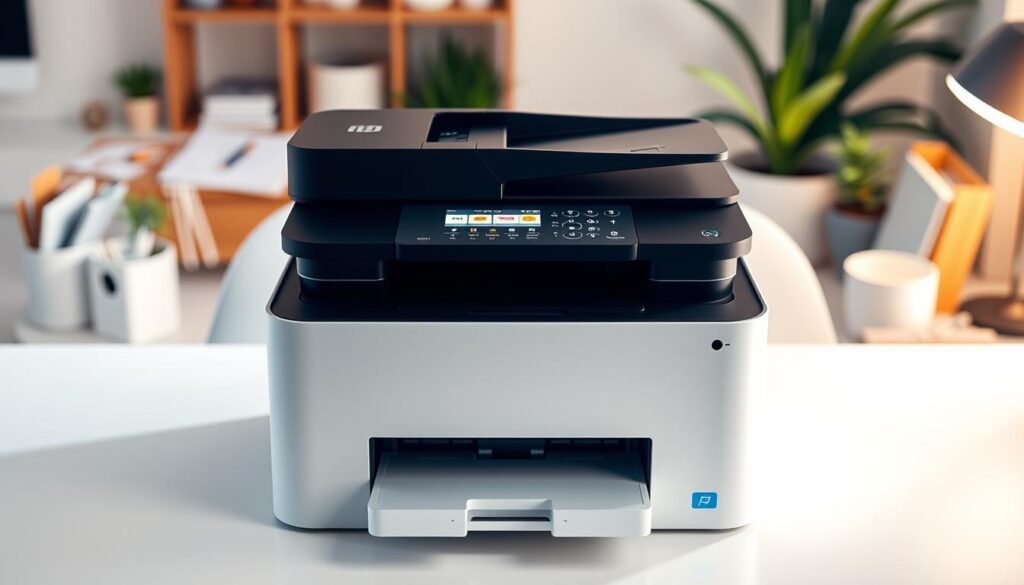
Match print volume and duty cycle to your workload
Start by estimating how many pages you print weekly and monthly. Pick a model with a recommended duty cycle that exceeds your peak month so the device lasts longer in an office setting.
Connectivity you actually use: Wi‑Fi, mobile apps, cloud
If you print from phones or tablets, prioritize strong Wi‑Fi support and reliable apps. Cloud workflows and simple installers cut setup time and let you scan or copy to an email or drive without a PC.
When fax still matters for forms and security
Decide whether fax matters for healthcare or legal forms—many AIOs include secure faxing. If you keep physical records, look for duplex and an automatic document feeder for multi‑page scan jobs.
- Balance color needs against mostly black text; inkjet suits photos, while laser handles heavy text.
- Check paper trays, media flexibility, and software simplicity for shared devices.
- Compare products by speed, monthly duty cycle, and supply costs before you buy.
Inkjet vs. laser: which type fits your print mix?
Deciding between inkjet and laser comes down to what you print most. If you send photos, craft pages, or glossy flyers, an inkjet often gives richer tones and smoother gradients. It handles varied media and usually costs less up front.
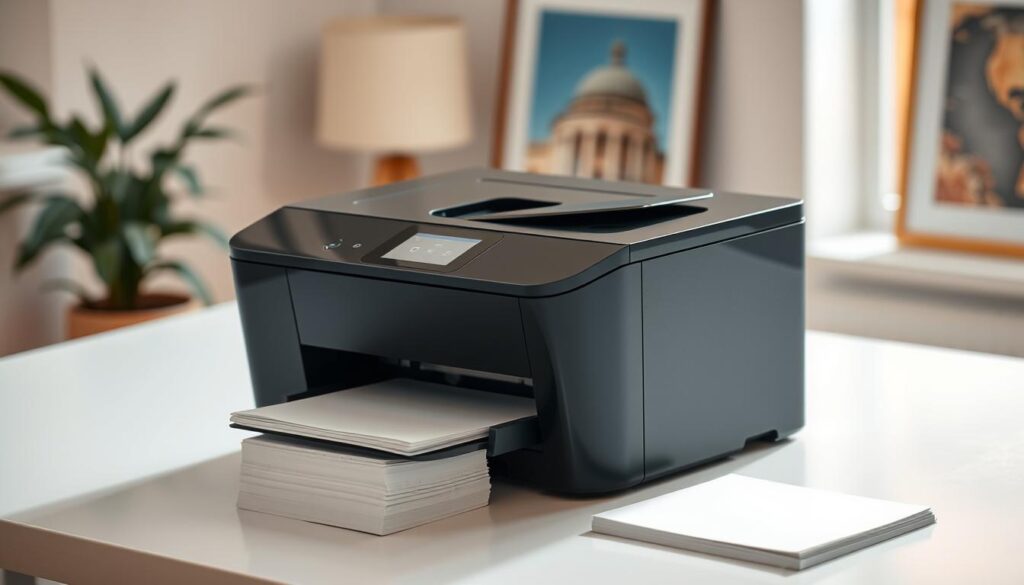
Inkjet printers for vibrant pages and photos
Choose inkjet when you need saturated graphics and good photo handling. Expect some drying time and possible smudge risk on glossy stock. High‑end inkjet models deliver excellent color accuracy for crafts and photo projects.
Laser options for sharp black text and heavy duty
Pick a laser printer if you mostly print black white documents and long reports. Toner gives crisp text, fast output, and lower fuss for large page counts. Lasers often warm up briefly, but they keep going with consistent results.
- Mixed needs: inkjet offers flexibility for schoolwork and occasional photos.
- High volume: laser saves time and may lower per‑page cost with high‑yield toner.
- Cost trade‑offs: compare ink vs. toner and consider subscription or high‑yield options.
Speed and pages per minute (PPM): what’s “fast enough” at home
Speed matters differently depending on whether you print essays, tax forms, or photos. Specs give a useful baseline, but your files decide actual throughput.
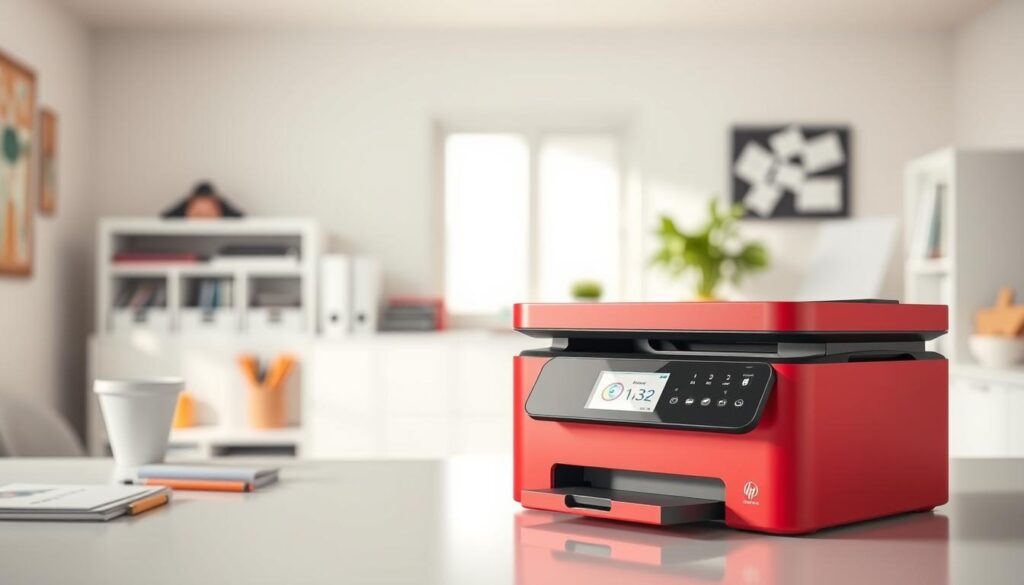
Real-world PPM versus lab specs
Manufacturer claims often list top pages per minute for ideal text jobs. In practice, mixed PDFs with graphics slow things down. For example, HP lists the OfficeJet Pro 9125e at up to 22 mono and 18 color ppm, yet testing showed about 12 ppm on a grayscale IRS PDF and 8.1 ppm on a color office PDF.
Duplex printing speed trade‑offs
Two‑sided jobs save paper but add time. Duplex printing requires extra handling, so expect throughput to drop. The 9125e tested around 8 ppm in duplex for both grayscale and color, a modest but noticeable slowdown.
| Task | Claim | Tested (simple) | Tested (duplex) |
|---|---|---|---|
| Text-only pages | 22 ppm | ~21.4 ppm | — |
| Grayscale PDF | 22 ppm | 12 ppm | ~8 ppm |
| Color office PDF | 18 ppm | 8.1 ppm | ~8 ppm |
| Scan (grayscale/color) | — | 9.2 / 6.5 per minute | 4.5 / 3.9 per minute |
Quick guide: if you run long batches, favor higher ppm and strong text throughput. If you print only occasionally, anything over 10 ppm will usually feel fast enough for daily tasks.
Document handling essentials: duplex printing and automatic document feeder
Good paper handling keeps small jobs from turning into a frustrating chore. Focus on reliable paths and simple tray controls when you pick a device. Consistency beats a long spec sheet when daily workflows matter.
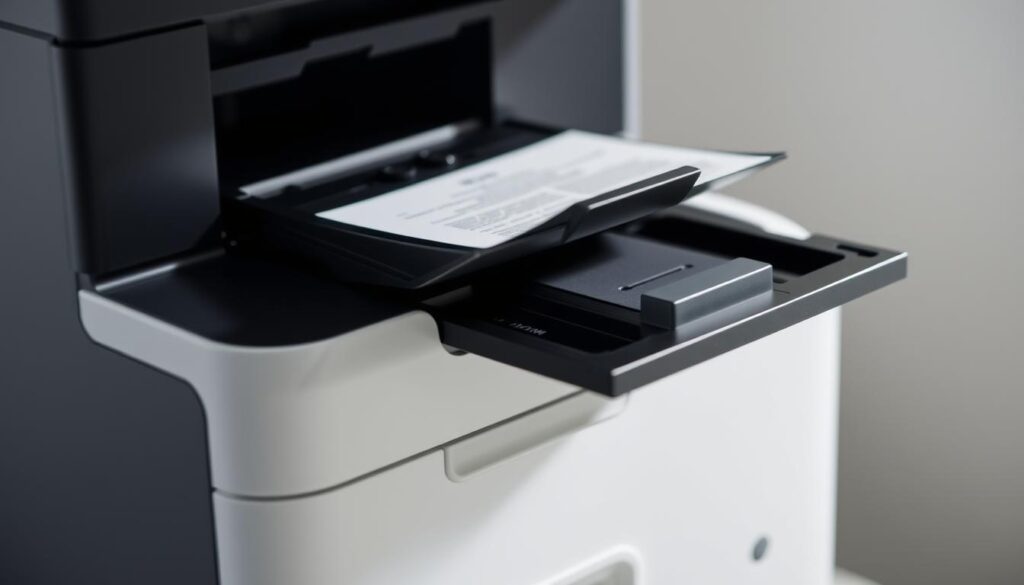
Single‑pass vs. two‑pass duplex scanning
Single‑pass scanning reads both sides at once and is faster for mixed stacks. Two‑pass systems flip pages and can slow longer jobs, though they may cost less.
Paper tray capacity and switching media
The OfficeJet Pro 9125e’s ADF produced straight scans in testing, even with crumpled sheets, and had few misfeeds. That kind of reliability matters if you often scan or copy multi‑page packets.
Keep in mind: the 9125e includes a single 250‑sheet tray. That is fine for most households, but you’ll swap trays for legal sizes, labels, or glossy résumé stock.
- Prioritize an automatic document feeder that avoids crooked pages when you feed stacks.
- Choose enough paper capacity to cut down on frequent refills and media swaps.
- Look for straight‑through paths and sturdy output trays to handle thicker stocks without jams.
Top pick spotlight: HP OfficeJet Pro 9125e
The OfficeJet Pro 9125e impresses with quick setup and polished software that gets you printing fast. You can complete setup in under ten minutes using the on‑screen keyboard and the HP Smart app. The app also shows ink levels and makes scanning or copying from your phone simple.
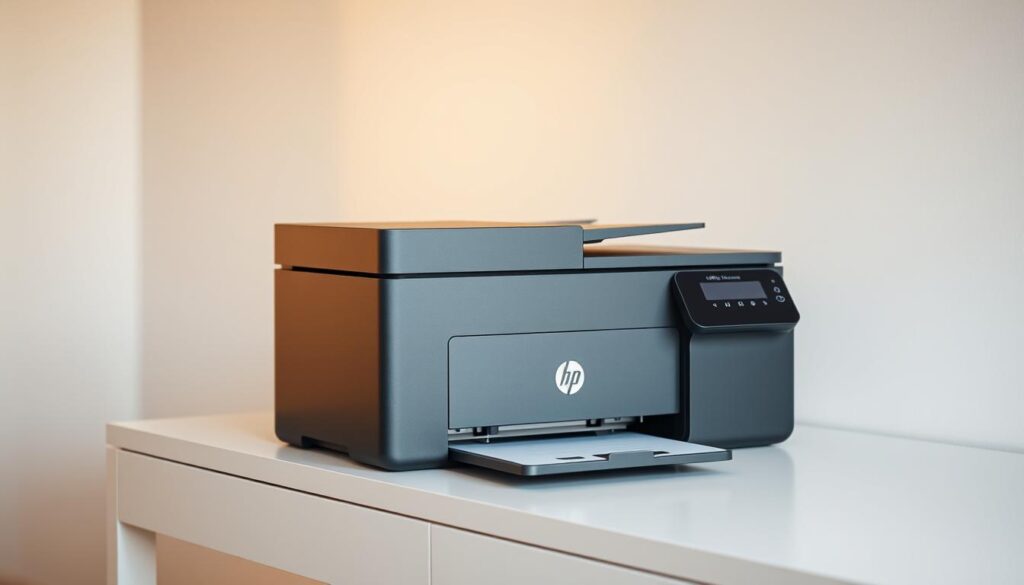
Setup and HP Smart experience
HP Smart detects the device quickly and guides cartridge install. You’ll see offers for HP+ and Instant Ink during setup. Enrolling in HP+ adds a two‑year warranty.
Print quality and photo handling
Text is sharp down to about 4‑point. Graphics are vibrant with little banding, and glossy photos look very good in Best mode, though tones trend a bit blue/magenta at high contrast.
Measured speeds and scanning
Expect about 21.4 ppm on simple text, ~12 ppm on grayscale PDFs, and 8.1 ppm on color PDFs. Duplex printing runs near 8 ppm. Scanning came in at 9.2 per minute grayscale and 6.5 color; duplex scans were 4.5 and 3.9 per minute.
Notable trade‑offs
Paper handling and ADF reliability were strong in tests. The main compromises are a single 250‑sheet tray and a small 2.7‑inch touchscreen that can mis‑tap. High‑yield 936e EvoMore ink costs moderate amounts if you buy outside subscription plans.
Should you opt into HP+ and Instant Ink?
Before you enroll, think about how regular your printing is and what you want from supplies and warranty.
Instant Ink plans run from 10 to 700 pages per month, and color pages count the same as black. Unused pages roll over up to three times your plan, and overages cost about $1 per extra set.
Cost per page and page‑based plans
If you print steadily, a page‑based plan can smooth monthly bills. The flat per‑set pricing makes budgeting easier for mixed documents and photos.
Lock‑in and always‑online rules
Enrolling via HP+ extends your warranty to two years and unlocks extra app and cloud features for the OfficeJet Pro 9125e.
But, HP+ locks the device to original HP ink and requires an always‑online connection. Your printer may pause if it loses internet access.
Warranty extensions and cancellation effects
If you cancel Instant Ink, any remaining ink in subscription cartridges becomes unusable. Plan cancellations around cartridge life to avoid wasted supplies.
- Good fit: you want set‑and‑forget deliveries and steady monthly pages.
- Be cautious: prefer third‑party ink or lack reliable internet? Skip HP+ to keep flexibility.
Laser upgrade paths: Color LaserJet Pro and LaserJet Pro MFP families
If crisp charts and professional proposals matter, stepping up to a laser model makes an immediate difference.
Why choose a color laser for your home office documents? A color laserjet pro produces cleaner charts and punchy text that helps reports and presentations look polished. Toner resists smearing and stays stable on the page, so handouts and mailings hold up.
Where lasers shine over inkjets in reliability
Laser engines are built for steady output. Laserjet pro and pro mfp lines use toner that won’t dry out and high‑yield cartridges that reduce interruptions. That makes a laser printer feel faster and more predictable during long runs.
- Pro MFP models add scanning, copying, and fax capability in a single laser device for heavier workflows.
- Toner yields mean fewer swaps and fewer supply hassles across busy weeks.
- Duplex & ADF on many LaserJet Pro MFP units give reliable two‑sided workflows for multi‑page packets.
Canon Pixma and photo‑leaning inkjets for family use
Canon’s Pixma line shines when your family leans toward photos, crafts, and projects that demand vivid tones. These models focus on producing glossy, borderless prints that look great on display and in school portfolios.
You’ll get strong color accuracy for everyday snapshots, with settings that bring out natural skin tones and lively skies. Use the best‑quality mode and supplied color profiles when color fidelity matters most.
Versatile media and project support
Expect good support for photo paper, cardstock, and labels so craft days run smoothly. Pixma models handle a range of sizes and finishes, making it easy to print posters, invitations, or school displays.
Costs and practical tips
These inkjet machines favor photo quality over document speed. That means color ink can be costly; choosing high‑yield cartridges lowers average cost per page.
- Great for: crafts, photos, and family projects that value image quality.
- Less ideal for: heavy text batches where speed and low per‑page text cost matter more.
- Tip: enable color profiles and Best mode for images you’ll keep or share.
Brother all-in-one printers: mobile tools and supplies that simplify life
Brother’s tools put essential print and scan controls on your phone so you can handle jobs between meetings.
Brother Mobile Connect for on‑the‑go print and scan
Download the free app and you can print and scan from your phone with a simple wireless setup. It helps when you’re juggling school forms, invoices, or quick photo copies.
Page Gauge visibility and supply planning
Page Gauge gives a clear visual estimate of remaining toner or ink so you plan refills before a deadline. That reduces surprises during busy weeks.
Refresh EZ Print Subscription: how rollover pages and savings work
Refresh EZ automates supply delivery and can cut costs—up to 50% on eligible color laser plans under select Color Laser High options.
New subscribers in the contiguous U.S. may get a free trial. Unused pages roll over within plan limits, but extra page set charges and taxes apply.
Note: if you cancel, subscription cartridges deactivate and must be replaced to keep printing.
- Use the Mobile Connect app to print and scan from virtually anywhere.
- Page Gauge helps you track pages and toner so you avoid last‑minute refills.
- Refresh EZ offers rollover pages that cushion busy months and streamlines supply orders.
- Brother Genuine supplies are designed for consistent results with Brother devices.
| Feature | Benefit | Notes |
|---|---|---|
| Mobile Connect | Print & scan from phone | Free app; wireless setup |
| Page Gauge | Supply visibility | Estimate remaining toner/ink |
| Refresh EZ | Automated supplies & savings | Up to 50% on select plans; trial available; rollover pages |
Wireless All-in-One Color home use printer, copier, scanner: our roundup picks by need
Find a model that blends speed, reliable two‑sided handling, and an easy app for daily work. Below are three compact picks that match common routines and budgets.
Best overall for balanced home offices
OfficeJet Pro class devices strike a strong mix of text speed, duplex reliability, and approachable software. You get steady print and scan performance, sensible tray sizes, and apps that move files to the cloud without fuss.
Best for heavy black & white with occasional color
A small laser printer AIO saves time on long text runs and costs less per page for black white jobs. Choose a model with a good ADF and high‑yield toner so you can copy and scan multi‑page packets quickly.
Best for photo‑forward families and crafts
Canon Pixma style inkjets give richer tones and borderless output for projects and albums. They handle varied media well and let you print, copy, and scan creative pages with fine detail.
“Pick a device that fits both your desk and your monthly page habits.”
- Check app quality and ADF behavior.
- Balance tray capacity and footprint for your space.
- Compare ongoing costs: high‑yield supplies or subscriptions can keep budgets predictable.
Ownership costs and supplies: ink, toner, and subscriptions
Supply plans and cartridge choices often determine your long‑term printing budget. Think beyond the device price and plan for monthly supply charges, overages, and warranty trade‑offs.
Instant Ink vs. Brother Refresh EZ
Instant Ink charges by pages per month (plans from 10 to 700). Color and black count the same, unused pages roll over up to three times your plan, and extra sets cost about $1 each. Note: HP+ extends warranty but locks you to original ink and requires an always‑online connection.
Brother Refresh EZ can cut toner costs—up to 50% on eligible plans—and often includes a free trial in the contiguous U.S. It supports rollover within limits, but subscription cartridges deactivate if you cancel. Billing continues monthly until you stop the plan.
High‑yield cartridges and cost per page
High‑yield cartridges are a clear alternative if you prefer no subscription. They lower the cost per page for steady printing and work well with laser models when long runs matter.
- Estimate your monthly pages so you avoid overages while not overpaying.
- Track real cost per page including supplies and occasional extra set fees.
- Consider cancellation effects: subscription cartridges may lock or deactivate after canceling.
Setup, apps, and wireless printing made easy
A short app-guided setup gets you printing and scanning from your phone in minutes. Start with the vendor app that matches your model to speed through discovery, driver install, and cloud links.
HP Smart supports quick add, remote settings, and access to the Embedded Web Server. During setup it often prompts to join HP+ and Instant Ink, so decide up front whether you want those services.
HP Smart, Brother Mobile Connect, and cloud workflows
Use HP Smart or Brother Mobile Connect to add your device and start to print, scan, or copy from mobile. Both apps show ink or toner, run maintenance tasks, and send scans to cloud folders you already use.
Avoiding installation pitfalls and promo lock‑ins
Watch for aggressive signup prompts and optional subscriptions during install. Keep firmware and the app current to fix quirks and preserve compatibility across phones and tablets.
- Tip: set shared access and defaults like duplex to save paper.
- Bookmark the device’s web admin page for quick troubleshooting.
- Decide about Instant Ink or similar offers before you finish setup.
Paper handling, reliability, and day‑to‑day usability
Smooth media feeding and a steady document path make routine printing far less stressful. In testing, the OfficeJet Pro 9125e showed nearly flawless paper handling, with steady feeds from both full and nearly empty trays.
The automatic document feeder kept pages straight and produced clean scans with no double‑feeds. That reliability saves time when you need to scan or copy multi‑page packets quickly.
Duplex output was dependable in our tests, producing two‑sided pages without excessive curling. If you default to two‑sided jobs, a smooth duplex mechanism matters for neat stacks and fewer interruptions.
The 9125e uses a single 250‑sheet tray, so expect occasional manual media swaps for legal sheets, labels, or photo stock. If you switch media often, plan for the extra handling or add a second tray where possible.
- Look for consistent feeding from both full and low paper trays so you avoid last‑minute jams.
- A reliable document feeder that keeps pages straight reduces time spent fixing misfeeds.
- Default duplex cuts paper use, but verify the mechanism doesn’t curl pages excessively.
- Button size and screen responsiveness affect daily usability; small touchscreens can slow you down.
- Well‑designed output trays prevent pages from spilling and keep printed pages in order.
Bottom line: prioritize predictable behavior over raw speed. A device that handles pages and media cleanly delivers better day‑to‑day quality for your printer and your workflow—especially when deadlines matter and color pages are mixed in with text.
Aesthetics and footprint: gear that fits your space
A compact, modern design keeps a device from dominating a small workspace and makes daily tasks more pleasant. The OfficeJet Pro 9125e drops the bulbous look of older models for sleeker lines and a neutral finish that fits a home office.
Measure first: give yourself room to open trays and the scanner lid so you’re not cramped during operation. Think about clearance behind and above the unit when you pick a spot.
Noise and vibration matter if the unit sits near living areas. Choose quieter models and stable feet to reduce distraction. A tidy cable path and front‑access cartridges make maintenance simple in tight spaces.
- Pick a design with rounded corners and solid hinges for a friendlier look and feel.
- Look for clear status lights and easy‑to‑reach controls as useful everyday features.
- Neutral finishes and modest scale help printers blend into shelves, desks, or media cabinets.
For photo projects and occasional color pages, favor a model that balances looks with function so it supports your workflow and complements the room.
At-a-glance spec checklist before you buy
Make a quick checklist of throughput, trays, and app support before shopping. That helps you compare real benefits, not just glossy claims.
Speed targets: aim for low‑teens ppm for mixed daily tasks and 20+ pages per minute if you run long text batches. Check manufacturer ppm claims and test notes so you know per minute throughput for mixed documents.
Two‑sided work: confirm automatic duplex and whether the scanner supports duplex printing for two‑sided copies. Two‑sided defaults save paper and time when set in the app.
Feeding and scanning: inspect the document feeder capacity and whether it’s single‑pass or two‑pass. A larger ADF reduces hands‑on time for multi‑page stacks.
Paper and trays: look for at least a 250‑sheet main tray and consider a second tray if you swap media often. Extra trays cut interruptions for labels, photo stock, or legal sizes.
Connectivity & supplies: verify dual‑band Wi‑Fi, mobile app support, and cloud scan/print options to match your devices. Match the recommended monthly duty cycle to your actual pages per month and price high‑yield cartridges or toner versus subscription plans before you commit to one printer.
Conclusion
Final pick matters: summarize your needs by matching daily tasks to the features you actually use. Choose a model that fits your page volume, ADF and duplex needs, and the media you print most so one printer works reliably for years.
If you want balanced performance, an OfficeJet‑class inkjet gives approachable apps and good photo handling. For heavy text and long runs, a compact laser AIO saves time and lowers per‑page cost. Photo‑leaning families benefit from inkjet richness, while upgrades to color laser models suit polished office documents.
Keep ownership costs predictable by weighing high‑yield supplies vs. page‑based subscriptions. Prioritize easy setup, strong mobile apps, and cloud workflows so your printers integrate into your office and home life and deliver the quality output you expect from these products.

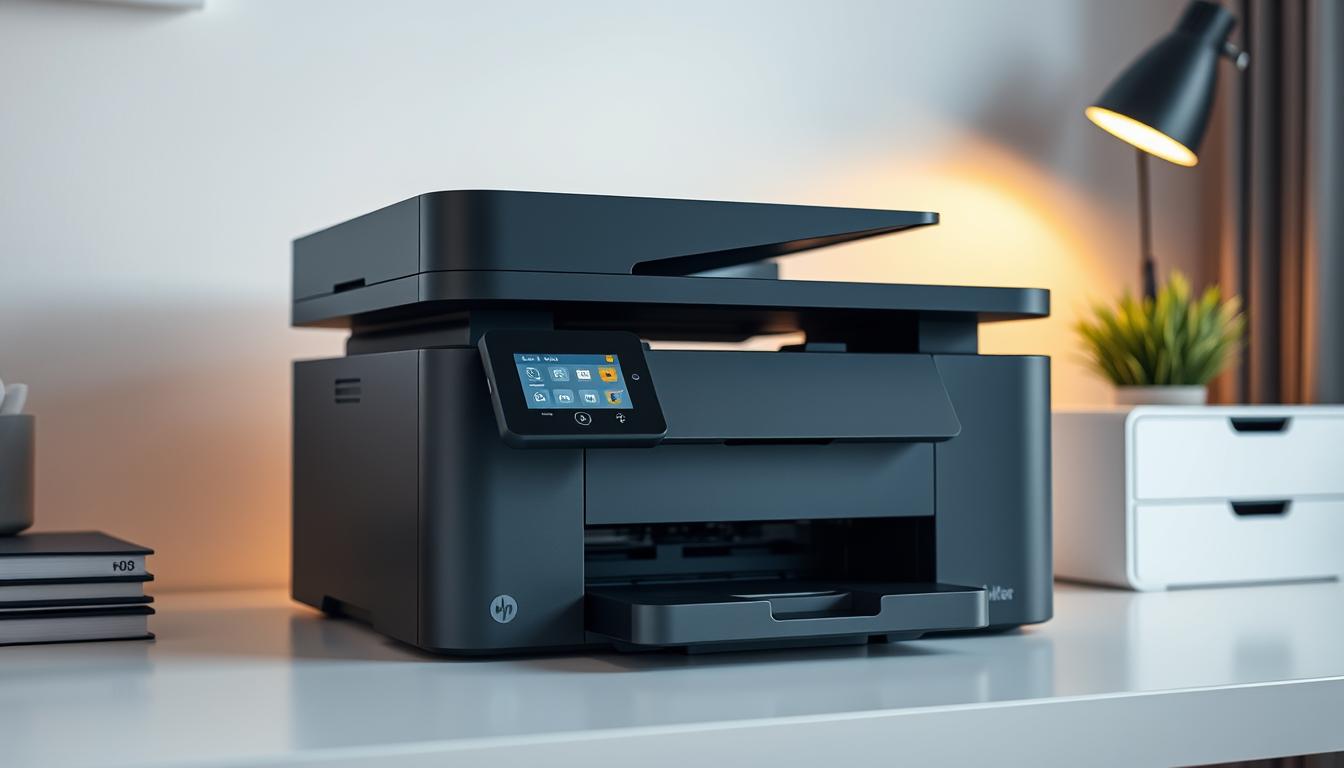
Leave a Reply